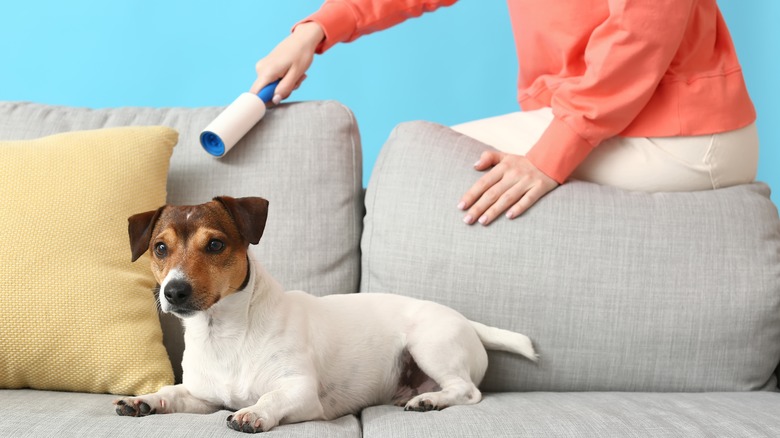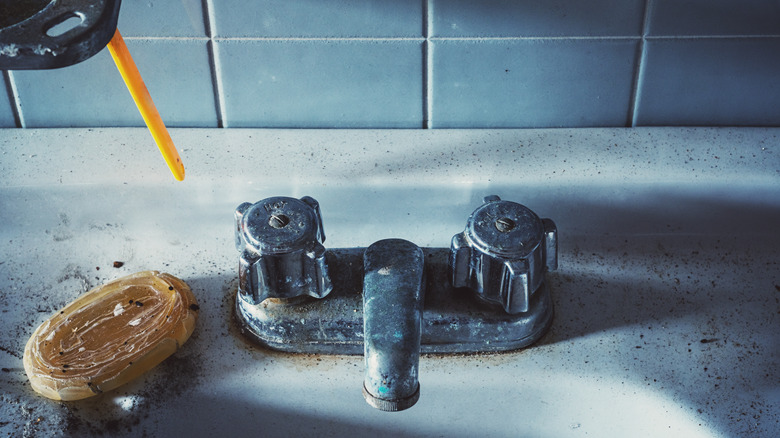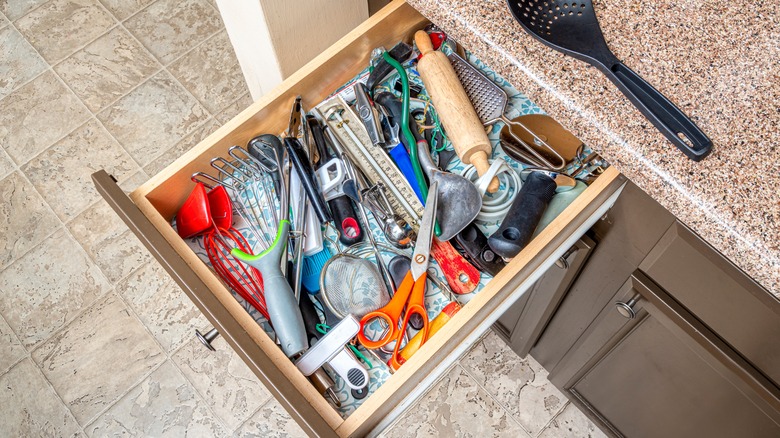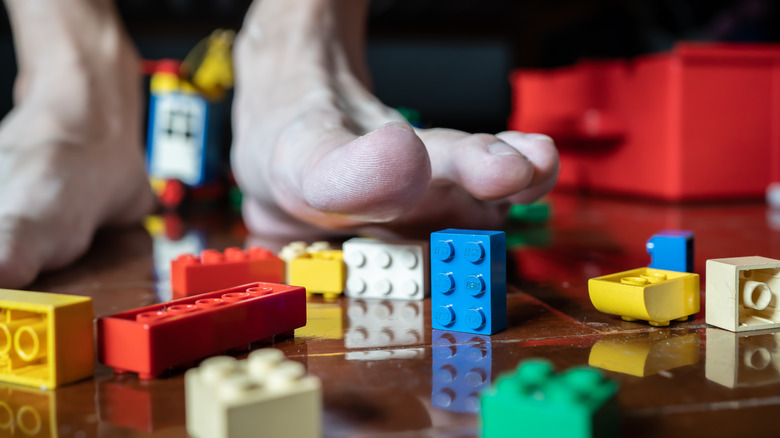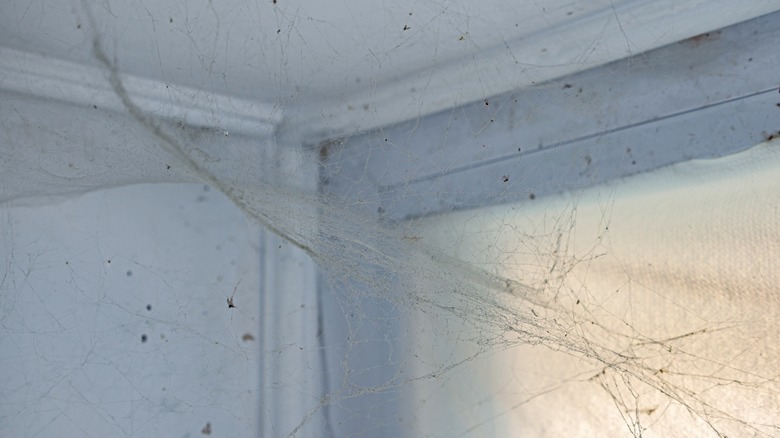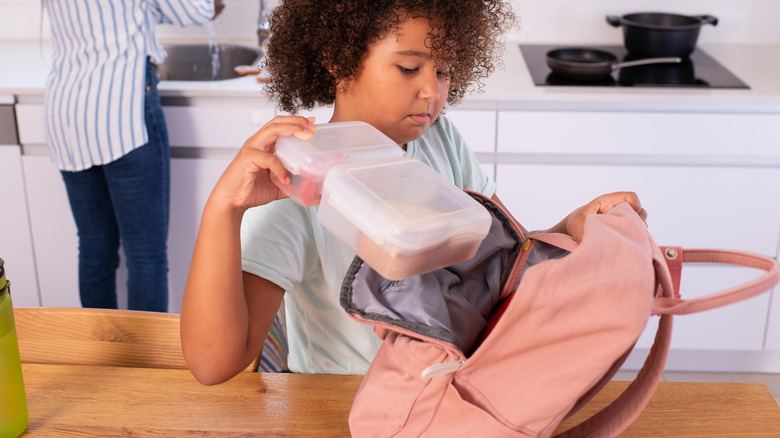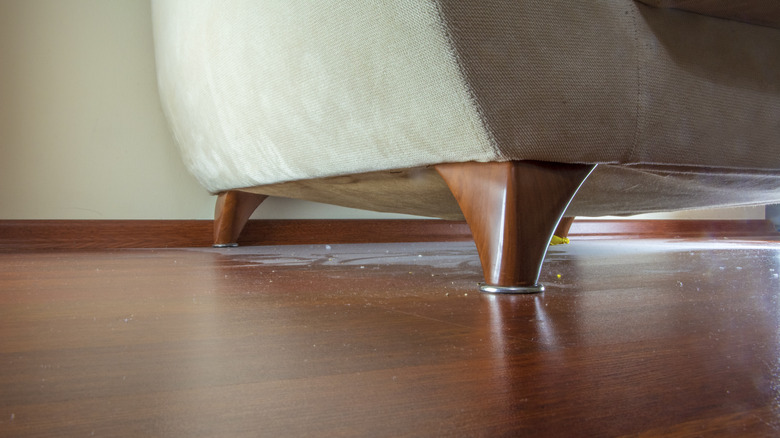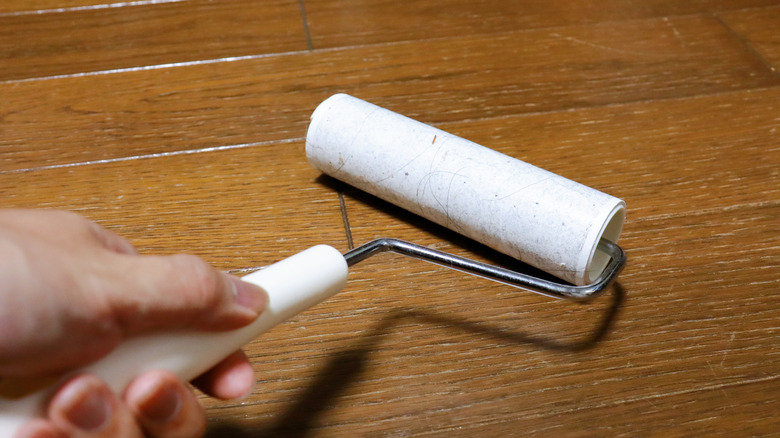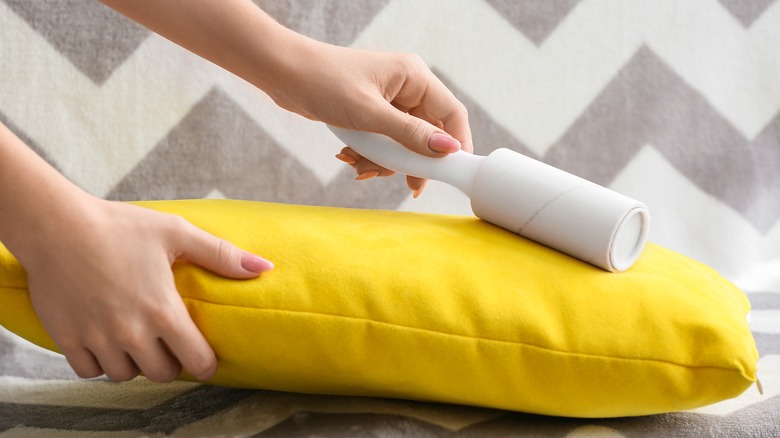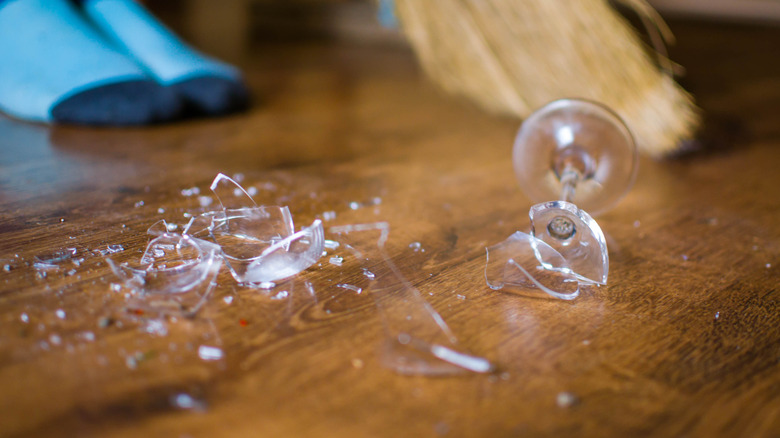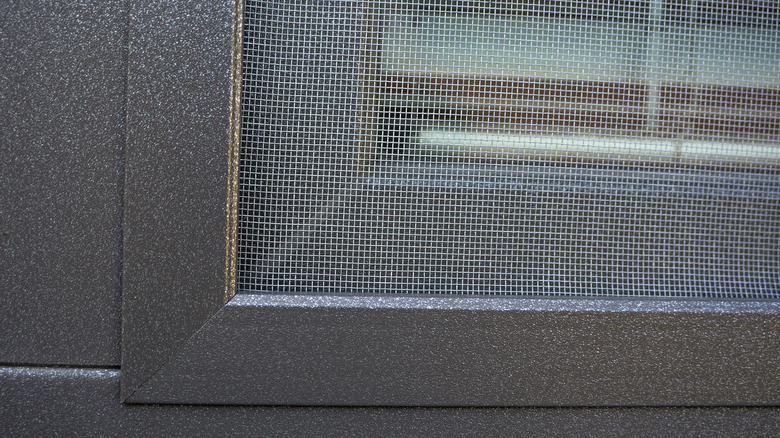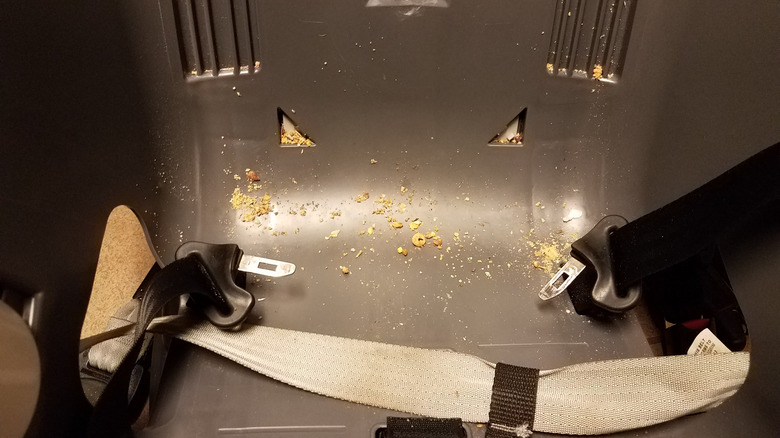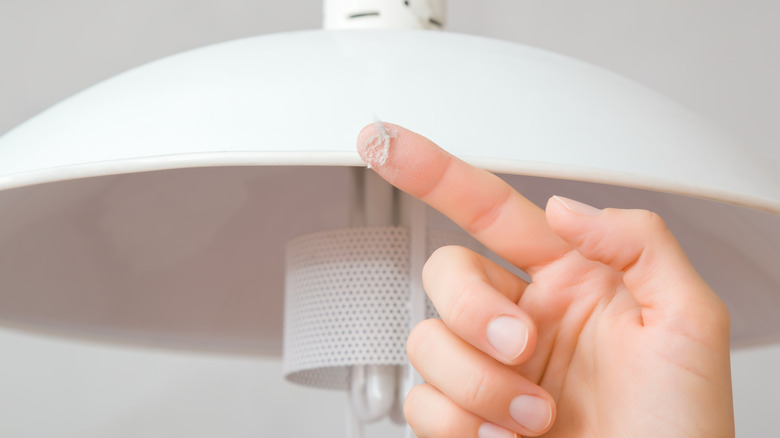16 Brilliant Ways To Use Lint Rollers To Make Cleaning A Breeze
In 1956, a man named Nicholas McKay had to chaperone a high school dance. The problem was, it was an unexpected request and he didn't have a chance to take his linty suit to the dry cleaner. So he created a makeshift contraption using a toilet paper tube, some masking tape, and a wire handle. It removed the lint from his outfit so well that he patented the invention, and the lint roller was born.
All these years later, the humble tool is still saving the day, but it's good for a lot more than fixing unsightly clothes. A basic lint roller can be one of the most valuable multi-purpose tools in your cleaning arsenal. There's a cleaning challenge in every room of the house (and car!) that it can solve, and solve quickly. From making it easier to keep kiddos' car seats spotless, to making one of the more unpleasant bathroom cleaning tasks a little more palatable, using a lint roller can do something for everyone.
Remove hair from hard-to-clean bathroom surfaces
Cleaning up the hair and dust that builds up in the bathroom is not a pleasant task. First, because, let's face it, it's pretty gross. And hair tends to end up in places that are hard to clean, like in the corners of the floor and behind the toilet and bathroom trash can. You might have to get on your hands and knees or contort yourself like an acrobat, to really scrub those areas.
A sticky lint roller addresses both problems. Pulling up hair and other bathroom debris with the lint roller lets you keep your hands clean and have minimal contact with the mess. Access can be relatively easy too. Making a few quick passes at the floor behind the toilet is probably going to be more comfortable than getting down there with cleaning spray and a sponge. And, you can always remove sheets from the roll and wrap them around your fingers when you need to clean nooks and crannies, like beard trimmings that have fallen around the sink's faucet.
Clean stuffed animals
Well-loved stuffed animals get dirty quickly but can be tough to clean. Either they're too delicate for the washing machine, or the kids who love them aren't willing to let them go long enough for a trip through the spin cycle. Of course, those beloved stuffies do have to get washed ever so often. But, in between those deep cleanings, a lint roller can help with spot cleaning. The adhesive is just sticky enough to pull the glitter or crumbs off a favorite stuffed animal at the end of a messy day.
A lint roller can help you keep your collectible or heirloom stuffed animals clean too. Maybe you keep your favorite childhood bear on a guest room bed or display a stuffed version of your college's mascot on a shelf. It may not take long for it to become covered in a fine layer of dust. Keep those sentimental treasures looking pristine by running a lint roller over them whenever you're cleaning the area where they're displayed.
Clean pantry shelves
Pantry shelves are a classic example of "out of sight, out of mind." If you're not diligent about cleaning those shelves, spilled food and dust can accumulate for weeks or even months without being noticed. That's not great, because keeping these free of spilled food and dust is important for more than just aesthetic reasons. It's also about keeping insects from making a home there. There are plenty of "pantry pests" (including various types of spiders, ants, and cockroaches) that would be happy to feast on your flour, rice, and other dry goods if given the chance.
Using a lint roller can help you reach the backs of your deepest and highest shelves for easy clean-up whenever you notice something has spilled. Add it to your weekly kitchen cleaning routine, too. Rolling a lint roller across the shelves is a quick way to collect everything from fine powders to chunkier things like pasta. Conveniently, you don't have to take everything out of the pantry to clean this way. Just clear one small section of a shelf at a time, run the lint roller across it, replace the items, and repeat with the next section.
Clean inside drawers
Like pantry shelves, drawers tend to accumulate dirt and gunk that's easy to ignore. Just toss stuff in there, shut it, and promise yourself that you'll pull everything out and clean the drawer another day. That day never seems to come, though, especially with drawers that are difficult or impossible to remove. How are you supposed to pull up all the debris that gathers in the corners when you can't shake the whole drawer out over a trash can? It might be easier to just close the drawer again and not think about it.
With a lint roller in hand, there's no reason to keep putting this off. Even if you don't feel like organizing the contents of the drawer, you can pull everything out and run the lint roller over the empty drawer to collect everything from stray paper clips to spilled grains of salt. Is gunk really wedged into the edges of the drawer? It might be useful to run a butter knife along those seams to loosen that material up so your lint roller will be able to pull it up.
Clean up after craft projects
Dreading cleanup should never stop you from pulling out the art supplies. Yet it might be tempting to tell kids they can't play with glitter today, just because you don't want to deal with the aftermath of such a potentially messy activity. Or, you might let your own crafting area get far messier than you'd prefer because you don't feel like cleaning the area when it's just going to get messy again.
A lint roller can be an essential tool for artists and crafters of all ages and disciplines. Use it to collect spilled glitter, beads, and sequins from tables, chairs, and floors after kids finish with art projects. A lint roller can also prove useful after Christmas. Keep one handy when putting away decor that leaves a shower of glitter, sequins, and tinsel behind. Anyone who sews, quilts, or embroiders can use a lint roller to collect stray threads from their work table and floor. Projects that involve cutting up paper also tend to get messy, creating tiny little confetti-like scraps that get everywhere. Using a lint roller to collect them will be quicker than picking them up one by one or finding a broom and dustpan.
Collect LEGOs and other tiny toys
If your household includes LEGO enthusiasts of any age, a lint roller might be the key to protecting your feet. Anyone who's spent any time around an open bin of them knows how excruciating it is to step on a stray block barefoot. Even if the builder does their best with cleanup, some of the tiniest pieces can get left behind, especially if they land on colorful flooring that makes them easy to miss. The same thing happens with tiny Barbie shoes or any other minuscule accessories that might come with your kids' favorite toys. You'll have to clean them up regularly. And, this is a monotonous task when you have a bunch of tiny objects to pick up from the floor.
Running a lint roller over those little plastic pieces should let you grab a bunch of them at once for quick and easy cleanup. If the play zone includes a patterned rug that tends to camouflage stray pieces, rolling one over the area might help you find them before you step on them. Plus, a lint roller is a simple enough tool that even little ones can use it to clean up after themselves.
Clear a desk mat of crumbs
Hey, there's a lot that you need to get done in a day, and sometimes that might mean you eat at your desk. Whether you tend to eat breakfast and lunch there every day, or only enjoy the occasional snack, keeping your work area free of crumbs is important. Dealing with an insect infestation is probably not going to help you do your best work. Plus, a dirty desk also isn't going to make the space feel as professional or productive as you may like.
A lint roller could be a must-have accessory for anyone who eats at their desk and wants an easy solution for managing mess. Keep one within reach so you can roll away any crumbs as soon as they drop. Even if you have a no-food policy at your desk, you might like having a designated lint roller there so you can always keep a tidy workspace that's clear of dust and debris.
Sweep away cobwebs
Cleaning cobwebs and spiderwebs from ceilings, baseboards, windows, and doorways is one of the grimmer cleaning tasks you have to take on. There's a reason walking through faux cobwebs is a standard part of a haunted house. They're creepy, and it's not pleasant to touch them.
Rolling a lint roller across cobwebs that cling to walls and ceilings lets you keep your hands clean. Plus, it can be an effective way to pull these wispy strands from textured walls and ceilings. This might actually help you keep your hands cleaner than if you used a broom to pull them down. While a broom might have a long stick that lets you keep some distance from those wispy webs, you'll ultimately have to pull those strands out of the bristles. Plus, a lint roller doesn't have that tedious length, making it easier to clean those tight, often-neglected spaces.
Clean the inside of a backpack, purse, or other bag
You may not want to look closely at the bottom of a purse, backpack, or work bag if it's been a while since you cleaned it out. Even when you pull out the crumpled papers, empty food wrappers, and rubber bands, there's often a sea of crumbs and other debris left behind. All that "mystery stuff" is pretty gross. It's also not anything you want mixing with a phone, laptop, or other electronic devices you or your kids might carry. Just a tiny bit of grit getting into the charging port or scratching the screen can cause big (and expensive) problems.
Use a lint roller to keep those deep recesses of bags free of icky and potentially destructive debris. If a standard lint roller doesn't fit inside the bag or its pockets, you can pull off individual adhesive sheets and press them into the seams and corners that need cleaning. This hack is ideal for bags that aren't made of washable materials or have textured surfaces.
Grab dust bunnies under furniture
Moving the couch and other large pieces of furniture to clean underneath them probably isn't part of your weekly cleaning routine. In fact, you might not be able to remember when the last time was that you cleaned under that dresser, TV stand, bed, or, well, any of your heaviest pieces of furniture. You'll get to that the next time you do a full spring cleaning, right? However, even though these spots are out of site and they don't see traffic, dust can build up quickly.
In the meantime, a lint roller makes a quick solution for visible dust bunnies that collect under couches, armchairs, and other hard-to-move furniture. If you've invested in a floor lint roller, it'll certainly sweep everything out from under the couch quickly. But, a standard lint roller will get the job done too. You can even use masking tape to affix it to a yardstick to reach further under deep pieces.
Spot clean a floor
Picture it: someone dropped a tortilla chip on the floor, and someone else stepped on it before it could be picked up. Now there are dozens of tiny tortilla chip shards scattered over that area. Annoying, yes, but is it worth hauling out the vacuum cleaner to take care of one broken chip? Unless you have a super convenient vacuum, you might be tempted to pick up the bigger chip pieces by hand and ignore the crumbs.
While a lint roller is no substitute for your powerful vacuum or broom, it might be a useful short-term solution to minor messes, especially if you have guests or you're on the way out the door. It can also be especially helpful for quick cleanup when snacks get dropped onto the carpet. Keep one handy and pull crumbs up before they get walked on and pressed further into the carpet fibers.
Clean furniture, comforters, and pillows
We tend to spend a lot of time curled up on our most comfortable furniture and wrapped up with our softest blankets and pillows. This means they are also some of the biggest mess magnets in our homes. At the same time, couch and chair cushions, blankets, throw pillows, and other fabric surfaces can be challenging things to keep clean. You're not going to throw your heavy fleece blankets and luxe velvet throw pillows into the washing machine every time they get a little dusty. And, some of your upholstered furniture and other fabric items may not be machine washable at all.
A lint roller is gentle enough to give pillows, blankets, and fabric furniture of various materials a sprucing up. It can pull up some of the surface dust, dirt, and crumbs that might cling to these surfaces. It's also the perfect tool for those "Uh-oh, company's coming over and I have five minutes to make the living room furniture look presentable" moments.
Pick up broken glass, fallen needles and other potential hazards
When you break a glass or ceramic item, the pieces can shatter into fine shards. This is especially true with thinner glass like lightbulbs or tempered glass like Pyrex. Dropping other sharp objects like pins or needles can lead to a stubborn mess. Picking any of these up with your hands can be nearly impossible, not to mention dangerous, leaving you with tiny cuts.
A lint roller can be a handy little tool for picking up these sharp pieces. Use it to collect broken glass after a wine glass shatters, or to collect things like tacks or sewing needles that have fallen to the floor. Sharp shards of metal or wood may be picked up using a lint roller too. And you can always grab it to clean up things you just don't want to touch. Roll a sticky sheet over things like dead bugs or someone else's used bandage to pick them up and toss them out without ever making contact using your bare hands.
Clean mesh screens
If the screens on your doors and windows don't get dirty frequently, they're probably not doing their job. Any screen that is exposed to the elements is bound to attract anything that might be swirling around in the air. Pollen, yard clippings, dead bugs, animal fur, cobwebs, and plenty of other stuff you wouldn't want to breathe in get trapped there (good job, screens!). But, all that buildup could eventually interfere with airflow. Letting pollen and dust sit on your screens also isn't ideal, especially if anyone in your household deals with asthma or allergy issues. Plus, noticeably dirty window and door screens don't scream, "curb appeal."
The humble lint roller can do a surprisingly effective job at cleaning the gunk from screen doors and windows. You'll probably go through a lot of adhesive sheets before you're satisfied, and you won't get screens as clean as you would with a hose or pressure washer. But you'll also stay dry and can get the job done in minutes. This strategy is perfect for cleaning window screens on higher floors, where you might not be able to wash them from the outside with a hose. Removable screens can be popped out, cleaned right there in the room, and reinstalled — no water required.
Clean out crumbs and debris from the car
Anyone who's ever cleaned out a toddler's car seat knows it's a big undertaking. It takes no time for a little one to push crumbs into the seat's crevices, not to mention how much debris ends up on the surrounding seats and floor. Keeping a lint roller in the car lets you stay on top of the mess so it doesn't accumulate into a Pigpen-style situation. One sticky sheet can collect a lot of crushed Cheerios. Plus, keeping the car seat clean daily means you can avoid the painful task of pulling the car seat out, deep cleaning it, and reinstalling it as often.
It's not just parents of young kids who should keep a lint roller in the car, though. It's a handy tool for cleaning other places in your car where crumbs, dust, and dirt might be found. Especially if you transport pets or eat while you drive, you're going to find regular uses for your designated car lint roller. You can just pull off a sheet and clean out all the gunk that accumulates in your cup holders or sweep dust off your dashboard.
Dust lampshades, wall decor and window coverings
When was the last time you cleaned your lampshades? It's a simple job that probably gets overlooked when you're doing your weekly cleaning. After all, your limited time is better spent cleaning visibly dirty things! But if you look closely, you'll probably notice that your lampshades are pretty dusty. A lint roller can whisk away dust and cobwebs without damaging most types of lampshades. Do a quick pass over both the inside and outside, and marvel at how much one sheet can pick up.
While you're lint-rolling your lamps, consider using the same technique to dust any canvas and/or fabric wall art. As with any cleaning strategy, it's always a good idea to do a test on a small patch of the surface to ensure you don't inadvertently cause damage. Dusty fabric window coverings and blinds can also be cleaned with a lint roller.
